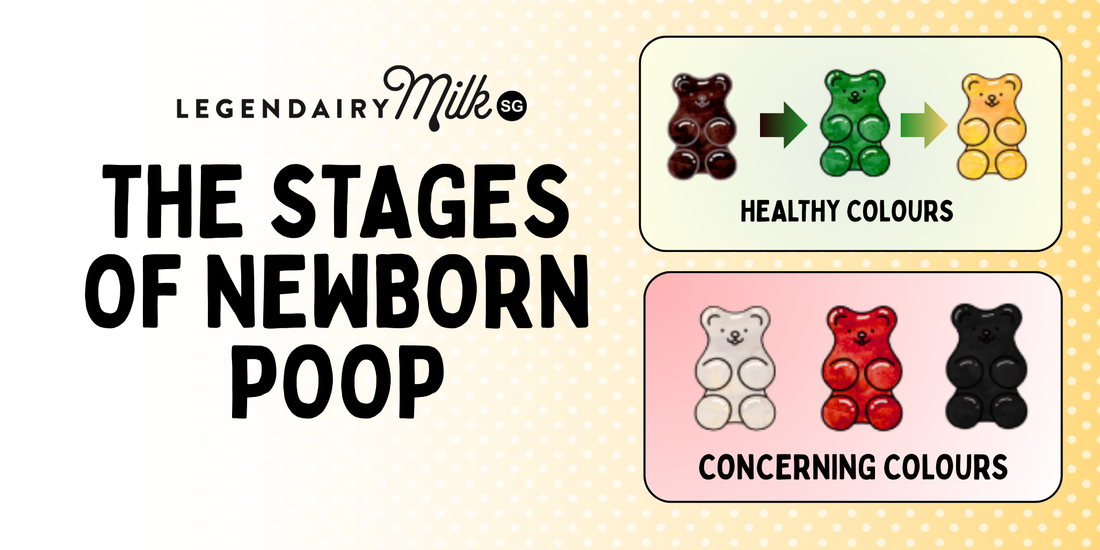
Newborn Poop: What’s Normal, What’s Not, and When to Worry
Share
Introduction
Few things capture a new parent’s attention quite like baby poop. Every diaper change can raise questions—Is this normal? Should it look like that? The truth is, newborn stool goes through many changes in the first weeks and months. These shifts in color, texture, and frequency are usually a healthy reflection of your baby’s developing digestive system.
By learning what to expect—from the very first meconium to the classic mustard-yellow breastfed poop—you’ll feel more confident and know when it’s time to check in with your pediatrician.
The Stages of Newborn Poop
1. Meconium: Baby’s First Poop
- Thick, sticky, and dark green to black in color
- Made up of amniotic fluid, mucus, and intestinal cells
- Appears within the first 24–48 hours after birth
- Signals that baby’s gut is working well
2. Transitional Stool: The Digestive System Wakes Up
- Color lightens from black to greenish-brown or yellow-green
- Softer and looser than meconium but still sticky
- Typically shows up around days 3–4 as colostrum turns into mature milk
- Indicates baby is starting to digest breastmilk
3. Breastfed Baby Poop: The “Mustard Stage”
- Bright mustard-yellow, soft, and often seedy in texture
- Frequency can range from a few times daily to almost every feed (especially in the early weeks)
- Has a mild smell compared to formula-fed stools
- A reassuring sign of healthy milk intake and digestion

What Texture Tells You
The “Seeds” in Breastfed Baby Poop
The little yellow “seeds” are simply undigested milk fats. Far from being a concern, they show that baby’s body is absorbing milk properly. These curds are most noticeable in the first months and may lessen as digestion matures.
Frothy or Foamy Poop
Sometimes stools look bubbly or frothy. This can happen if baby gets more foremilk (lactose-rich milk at the start of a feed) than hindmilk (the creamier, fat-rich milk that follows). Letting baby finish one breast before switching to the other often helps balance intake.
Mucusy Poop
A little mucus can be normal while baby’s gut is adjusting. But persistent mucus—especially with streaks of blood—could suggest sensitivity to cow’s milk protein or another digestive issue. If paired with fussiness or rash, it’s worth a pediatric check-in.
When Poop Colors Raise Questions
Green Poop
Often harmless, especially in the transitional stage. It can also point to a foremilk-hindmilk imbalance if stools are consistently bright green and frothy.
White or Chalky Poop
This is a red flag. Stool should never be white, gray, or chalky—these colors may mean bile isn’t reaching the intestines, which can signal a liver or bile duct issue. Contact your pediatrician immediately if you see this.
Foremilk, Hindmilk, and Digestion
Breastmilk naturally shifts during a feed:
- Foremilk: thinner, higher in lactose, quenches thirst
- Hindmilk: creamier, higher in fat, supports satiety and growth
Too much foremilk without enough hindmilk can lead to gassiness, green stools, and fussiness. Ensuring baby nurses long enough on one side helps provide the full balance.
When to Call the Pediatrician
Seek medical guidance if you notice:
- No stool in the first 48 hours
- Ongoing white, red, or very dark stools
- Signs of dehydration (fewer than 3 wet diapers daily)
- Persistent mucus or blood in stool
Starting Solids: What to Expect
When solids enter the picture (around 6 months), poop changes again. Expect thicker consistency, stronger odor, and colors that reflect what baby eats—orange from carrots, green from spinach, even tiny undigested food flecks. Occasional hard or dry stools can mean constipation, often helped by more hydration or fiber-rich foods.
Conclusion
Your baby’s diaper may be full of surprises, but most stool changes are simply part of normal growth. From tar-like meconium to seedy yellow milk stools, these shifts mirror your baby’s digestive journey.
The best measure of health isn’t just poop—it’s steady weight gain, plenty of wet diapers, and a content, alert baby. If something ever feels off, trust your instincts and reach out to your pediatrician. With the right knowledge, you can approach diaper duty with confidence, knowing that every stage of poop tells a story about your little one’s development.
